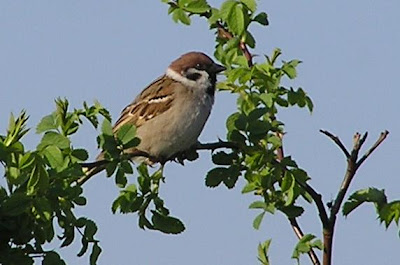The Tree Sparrow Recovery Project
Tree Sparrows Passer montanus are found throughout Europe and Asia and differ from the more familiar House Sparrows by having a chocolate brown cap and a conspicuous black cheek spot.
Tree Sparrows declined in the U.K. by a staggering 95% between 1970 and 1998 and are now "red-listed" as a species of high conservation concern. Accordingly, the Royal Society for the Protection of Birds (RSPB) is cooperating closely with other professional and voluntary organisations and the farming community in order to promote practices that will encourage the recovery of this species.
Among the most important are modifications to agricultural practices (for example, the retention of stubbles through winter rather than ploughing in) and the provision of suitable nesting places. Fortunately Tree Sparrow readily take to nest boxes, and there have been considerable success stories in areas where nest boxes have been provided.
Part of this project involves RSPB Project Officer Catriona Glendinning (in collaboration with Cumbria Wildlife Trust, the Tree Sparrow Recovery Project and the Cumbria Waste Management Environmental Trust) who visited my research site at Roudsea Woods and Mosses National Nature Reserve to install a batch of nest boxes of suitable dimensions favoured by Tree Sparrows.
 Catriona arrives at Roudsea Woods and Mosses NNR with her
Catriona arrives at Roudsea Woods and Mosses NNR with hervan loaded with nest boxes for Tree Sparrows
 Having established a suitable location to place the nest boxes,
Having established a suitable location to place the nest boxes, Catriona quickly gets to work nailing them up.
 Unlike many territorial species (e.g. the tit family) that are attracted to nest boxes, Tree Sparrows are colonial and so nest boxes are set up in clusters.
Unlike many territorial species (e.g. the tit family) that are attracted to nest boxes, Tree Sparrows are colonial and so nest boxes are set up in clusters.Now, it is a waiting game. I shall be responsible for monitoring the boxes over the coming years. The earliest possible occupation could be the spring of 2010 and we shall be waiting eagerly to discover if nestlings like the Tree Sparrows in the picture below are reared in the boxes.
 A brood you young Tree Sparrows in a next box.
A brood you young Tree Sparrows in a next box. Please click on the picture for image source.



11 Comments:
Very interesting - I'll look forward to your updates. PS Your loaves of bread look yummy - your new kitchen in the former post makes me hungry!
quality post mate. Tree sparrows and house sparrows here- same distinction?
Another beautiful shots.
Great with the birds in the nest, well done!!
Have a nice SWF.
How are the house sparrows doing these days?
Let's hope the boxes aren't used by wasps as their nest, like wot they did in the box I put up!
Lovely photos :o) This is a great project. I was sorry to miss Catriona when she popped in to see the beavers. Hope it is very successful.
love the 1st photograph so nice.. and wanted to see how it works out for you ... will wait for it
This is so lovely.. I always love the birds in the nest. Let us know the updates..
Good luck with the tree sparrow project, I hope the little devils will take to their new homes and breed like rabbits! Acually, I have no idea about the difference between tree and house sparrows. I have a big bird house on a pole in my back yard, it has 27 apartments, and it's always full! House sparrows I think.
Your new kitchen is fab! I've just put in a new kitchen too, pics on my blog but I think you'll have to scroll down to "older posts" to see it as I posted a couple of weeks ago. New kitchens are WONDERFUL!
BTW what happened to taht naughty sister of yours, she is ignoring her blog completely!
Very good, and I commmend you for the work you are doing.
I like their distinct markings from the House Sparrows here, and the fact that they colonize. But whatever the species, they ought all to be preserved.
A worthwhile endeavor. Good fortune to you and to the sparrows.
Here are some words from Jesus that came to mind from your post:
"Are not two sparrows sold for a penny? And not one of them will fall to the ground apart from your Father. But even the hairs of your head are all numbered. Fear not, therefore; you are of more value than many sparrows."
Post a Comment
<< Home